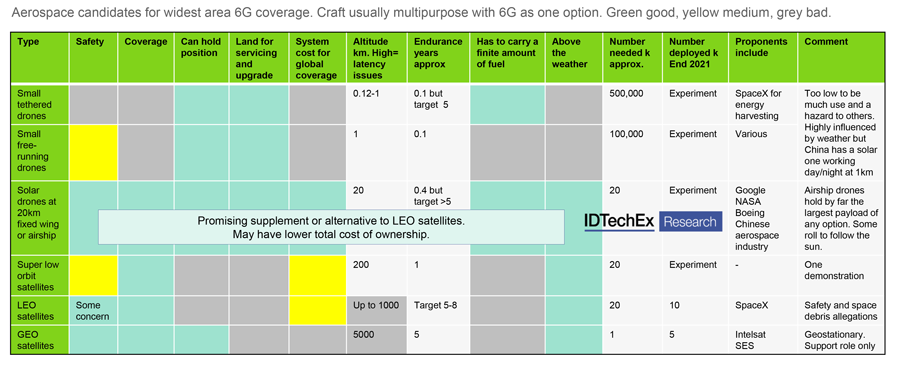6G Communications will become one of the largest technology investments. It is currently in the healthy first stage of promising everything to widely deploy some in 2030. Meanwhile, 5G to “Beyond 5G” awaits.
We upgrade telephony to be more useful every 10 years. The new IDTechEx report, 6G Communications Market, Devices, Materials 2021-2041, predicts 6G communications may be more thing-to-thing than human communication. Once again, frequency increases a magnitude. We may mimic 5G in starting at the easy bottom, then go up another magnitude to grab extra benefits. 5G went from GHz level to tens of GHz. 6G may start at a few hundred GHz, then employ 1THz.
Only 6G can widely serve the exponential growth beyond 500 billion connected machines in 2030, real-time holographic communication, the future of virtual reality and empowerment of the poor in realistic timeframes. Expect cell-less communications and Wireless Information and Energy Transfer. WIET is 26 billion passive-RFID tags yearly (IDTechEx analysis). Some sense at the instant of being interrogated. 6G WIET promises that on steroids, even charging your smartphone.
6G will serve airliners at 10 km using Free Space Optical FSO links and deep underwater with fiber-optic links. Internet of Things nodes real-time monitoring billions of trees and ocean oil spills in 3D, billions in concrete structures? Hold on. This sits awkwardly with the consensus that local 6G has to be at terahertz frequencies to get magnitude-or-more improvements in data-rate, capacity, and latency. Terahertz is the Wild West of physics and electronics: little understood, even less demonstrated. They call it the Terahertz Gap. However, this we know. Beam spreading and attenuation, combined with feeble transmission technologies, currently limits these sad pencil beams to a few meters on earth. They are stopped dead by almost anything. We may need electronic wallpaper to get them round the house and many electronic billboards boosting and redirecting them outside.

Raghu Das, CEO of analysts IDTechEx, advises, “Massively-deployed Reconfigurable Intelligent Surfaces RIS are known by six other names just to confuse you. They will be essential for 6G to boost, redirect, collimate, polarise and otherwise manipulate those feeble THz beams using metamaterials embedding new active devices.”
Even at this early stage, some myths are emerging. They are:
6G will be everywhere. No. It flies in the face of the megatrend of eliminating infrastructure. THz local investment will never be justified to put 6G local infrastructure “everywhere.”
Widest-area 6G backhaul/ fronthaul is a done deal with thousands of Low Earth Orbit satellites recently flung up there and maybe 60,000 in prospect due to competition? No. They have a growing number of legal, safety, light-pollution, repair, latency and other issues. Solar fixed-wing and airship drones intended to be aloft at only 20km for a similar time of 5-7 years have huge advantages of holding position, far-lower latency and cost, easy repair and heavier payloads. Add them. Smaller numbers suffice.
6G should benefit IoT in locations with long-distance optical links. Serving unpowered devices such as 30-year, multi-sensor IoT nodes with fit-and-forget supercapacitors will be excellent. For more, existing energy harvesting is too weak and intermittent to power 99% of envisioned IoT nodes but add 6G WIET. Nonetheless, affordable 6G IoT everywhere in tens of billions yearly? Unlikely.
6G is essential for autonomous vehicles. No, not even desirable. The Tesla approach is to make a car you can put anywhere and it will navigate safely without being connected to any wireless system. Even the interim stage of LIDAR using ongoing mapping does not need connectivity. Relying on a new form of connectivity that requires exceptionally complex hardware everywhere would be downright dangerous. That is why the telecom operators went quiet about the 6G robot vehicle idea. Vehicles need connectivity and 6G may provide a better form but that is another matter.
License 6G bands near 10THz for even greater 6G performance? Sadly, in air, there is a nasty jump in attenuation beyond 1THz and active components get really challenging. This is not desirable or achievable.
Nevertheless, those arguing B5G means no need for 6G are wrong. Basic physics. IDTechEx report, “5G Technology, Market and Forecasts 2020-2030” explains and the IDTechEx 6G report tracks even more-demanding requirements arriving, making this more of a myth. We need 6G.






